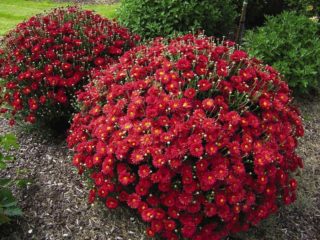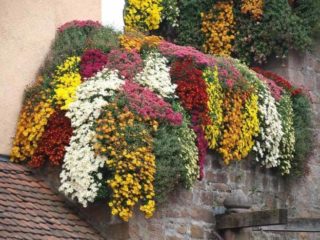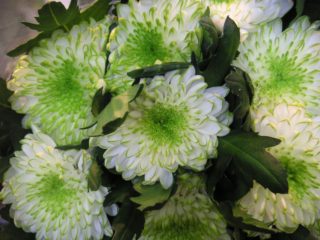Content
- 1 Features of growing chrysanthemum Santini
- 2 Varieties of chrysanthemum Santini
- 2.1 Chrysanthemum Santini Bouncer
- 2.2 Chrysanthemum Santini Country
- 2.3 Chrysanthemum Santini Aurinko
- 2.4 Chrysanthemum Santini Chrissi
- 2.5 Chrysanthemum Santini Aviso
- 2.6 Chrysanthemum Santini Madiba
- 2.7 Chrysanthemum Santini Sun Up
- 2.8 Chrysanthemum Santini Jenny Pink
- 2.9 Chrysanthemum Santini Pompon
- 2.10 Chrysanthemum Santini Doria
- 3 Planting chrysanthemum Santini
- 4 Chrysanthemum Santini Care
- 5 Diseases and pests
- 6 Reproduction of chrysanthemum Santini
- 7 Conclusion
The compact bush chrysanthemum Santini (Santini Chrysanthemums) is a perennial plant that does not require pruning and formation. This kind does not exist in nature. The emergence of the hybrid is the result of painstaking work by Dutch breeders.
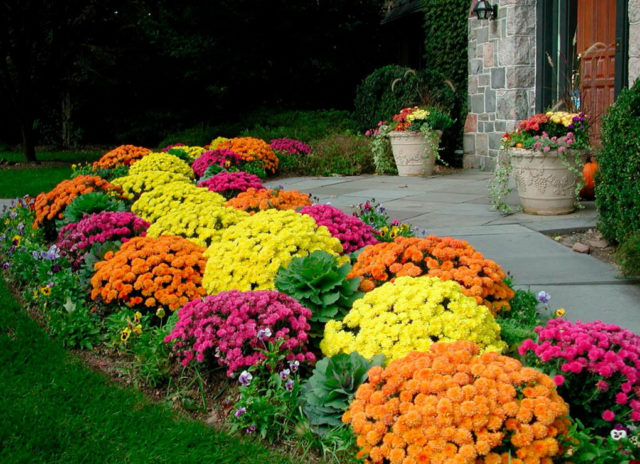
Chrysanthemums Santini of different varieties go well in the composition
Features of growing chrysanthemum Santini
Chrysanthemums are not demanding on growing conditions, unpretentious in care, therefore they have gained wide popularity among florists and gardeners.
Growing and caring for this variety is provided by analogy with other types of bush chrysanthemums. It is important to remember that the plant belongs to the category of hybrids, which means that it will not work to grow a flower bush from seeds.
The peculiarities of growing and caring for chrysanthemums in the conditions of central Russia are in preparing the plant for wintering. Despite the fact that the species belongs to frost-resistant, for the winter Santini bushes must be covered or transplanted into pots, transferred to the room.
Severe frosts, which are often observed during the Russian winter, can be disastrous for an unprotected plant.
Santini chrysanthemums are planted in open ground in May, when the threat of return frosts has passed. Planting in greenhouses is carried out about a month earlier - in mid-April.
The plant prefers loose, fertile soil. Does not like stagnant moisture. Therefore, in some cases, the use of a drainage system is required.
This species needs regular abundant watering and good lighting so that its shape and decorative qualities are not lost.
Varieties of chrysanthemum Santini
All varieties of compact bush chrysanthemum Santini can be conditionally divided according to the main criteria that distinguish them. This is the height of the bush and the diameter of the flower.
For their compactness, flower bushes have been recognized by lovers of indoor flowers. The species also thrives on potted plants. It is noteworthy that the root system of different varieties is identical: the roots are close to the surface, have a modest size and average thickness.
There are quite a few varieties of Santini. Planting, growing and caring for each species does not differ from the basic activities for all bush chrysanthemums. The differences are in external indicators, flowering times.
It is problematic to list all the known varieties of the Santini subspecies, since there are so many of them.
Chrysanthemum Santini Bouncer
Bouncer (Bunser) is a variety that looks like a chamomile. A typical Bouncer has white petals and a greenish center. There are several color options - pale cream, green, yellow, red.
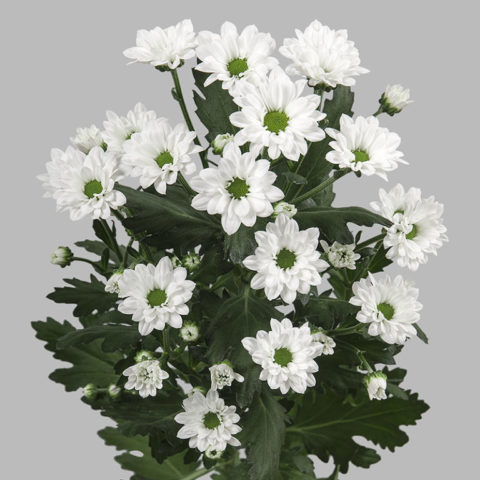
Chrysanthemum Santini Bouncer looks like a chamomile
Distinctive features: thin stem, height up to 40 cm, inflorescence diameter less than 4 cm. This variety is considered one of the most popular among gardeners in the Moscow region. Widely distributed in other regions of the country.
Chrysanthemum Santini Country
The green country variety Santini chrysanthemum bush looks original due to its inflorescences, collected from sharp petals. They are small in size, have a spherical shape, resembling a bump in appearance.
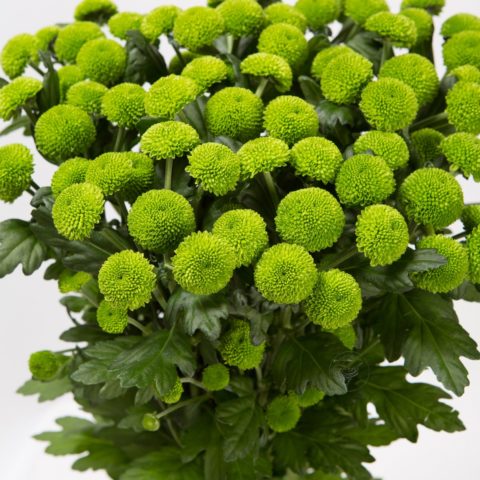
The chrysanthemum Santini Country has small green inflorescences
Coloring of flowers from yellow-green to pure green. The core merges with the petals.
Chrysanthemum Santini Aurinko
Outwardly, Santini Aurinko is similar to the Country variety. Flower petals have an oblong shape, collected in spherical (pompous) inflorescences.
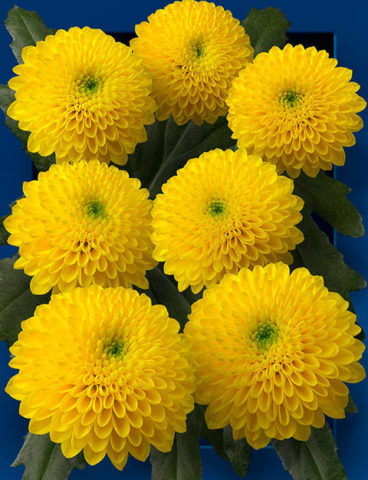
Santini Aurinko has pompous yellow flowers
A variety of a beautiful yellow shade with a greenish center. Compact bushes with flowers of small diameter (up to 4 cm).
Chrysanthemum Santini Chrissi
Chrysanthemum Santini pink of the Chrissi variety is distinguished by a high stem. The inflorescences are medium in size. The petals are carved in pink shades, the center is green.

The inflorescences of Santini Chrissi have carved petals of a beautiful pink color
Outwardly, Chrissy resembles a chamomile with double petals that are different in color.
Chrysanthemum Santini Aviso
Unlike other varieties, Aviso has a rather tall stem. Santini Aviso is a chamomile chrysanthemum with rounded petals.

Santini Aviso has a rather bright color and splendor
The variety has a rather pronounced spectacular color: the petals are bright yellow, the core is green.
Chrysanthemum Santini Madiba
The main distinguishing feature of the Madiba variety is in the size of the inflorescence: these are small flowers, double or semi-double. The color of the petals can be white, pink, yellow or red.
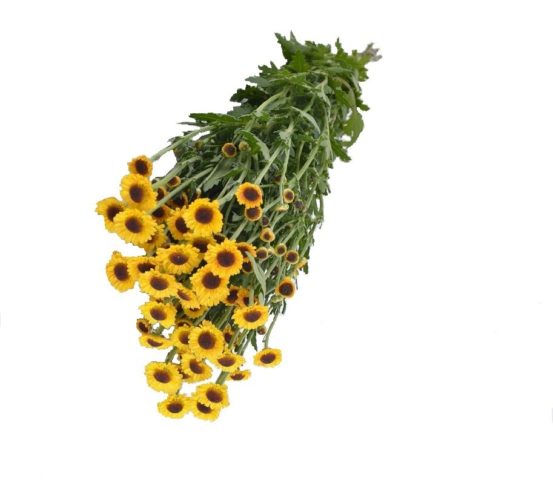
The Madiba variety has rather small inflorescences.
At the same time, the indicator remains unchanged - the diameter of the inflorescence is only 2 cm.
Chrysanthemum Santini Sun Up
Chrysanthemum Santini white variety Sun Up looks like a chamomile, the main difference of which is that its petals are quite small relative to the middle.
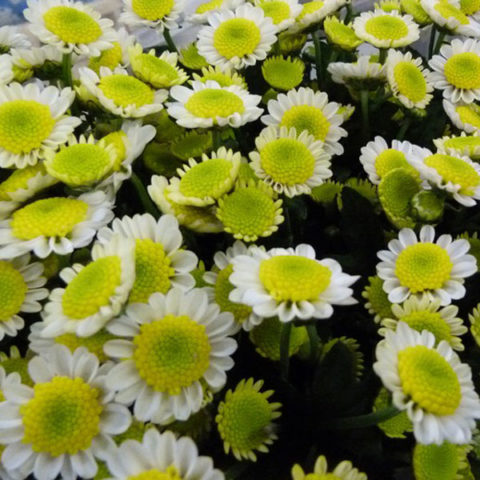
Santini Sun Up has a bright yellow broad center and short petals
The short petals are white, and the wide, large core is bright yellow.
Chrysanthemum Santini Jenny Pink
The compact chrysanthemum bush Santini Jenny Pink has an unusual color: pale pink petals around the circumference, towards the center - greenish.

Jenny Peak is characterized by an unusual coloring
Inflorescences are small, spherical in shape. The petals are oval.
Chrysanthemum Santini Pompon
Santini Pompom is a type of compact chrysanthemum with medium-sized spherical inflorescences. The colors are varied: from white to lilac.
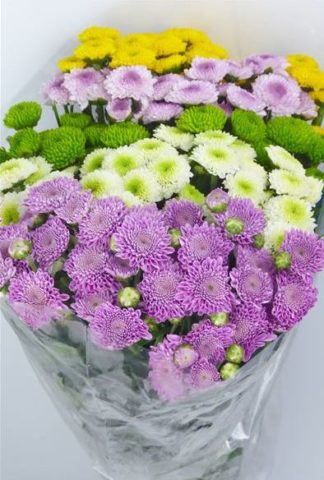
Chrysanthemum Santini Pompon (mix) are popular with florists for their variety of tones
Petals are oval in shape, collected in lush inflorescences. The color of the petal towards the center changes to a more intense one.
Chrysanthemum Santini Doria
The spherical inflorescences of the Doria variety are medium-sized, but very effective. The petals are pink-lilac. The middle is greenish.
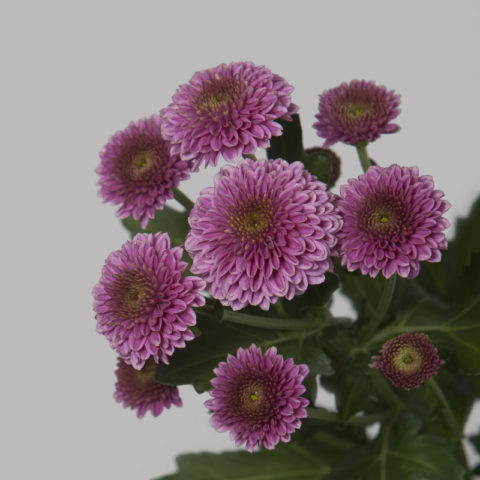
Long flowering is characteristic of Santini Doria
Planting chrysanthemum Santini
In central Russia, Santini chrysanthemums are planted in open ground from the second decade of May, at a time when the threat of frost has passed. Before you start planting, it is worth determining the location. It is important to choose it according to the following criteria:
- the soil should be loose, well-drained naturally;
- there should be no stagnation of water in the selected place;
- fertility - on poor soils, the plant does not take root well, which will later affect the development and flowering;
- the place should be well lit.
Preparation of soil and planting capacity
It is not enough just to find the optimal place; it is necessary to prepare the landing sites.If the soil is not loose enough, drainage will have to be done to avoid stagnant water.
In cases where planting is carried out in pots or planting containers (boxes), it is necessary to prepare the soil. It should be light, fertile. Potting mixes, which can be purchased at specialized stores, are well suited for these purposes.

Subspecies Santini prefers light fertile soils
A drainage layer must also be laid on the bottom of the pot or drawer. Expanded clay, broken brick or ceramics are used for this. Experienced flower growers often use old flower pots as drainage, which must first be broken into small pieces.
New containers for planting must be well rinsed with water and soda or a solution of potassium permanganate. Containers that were previously used must be disinfected. To do this, fill them with soda or permanganate solution for 1 - 2 hours.
Preparation of planting material
When purchasing planting material, you need to pay attention to the root system. In chrysanthemum Santini, it is quite compact, the body of the root processes is thick. There should be no dark spots or rotten areas.
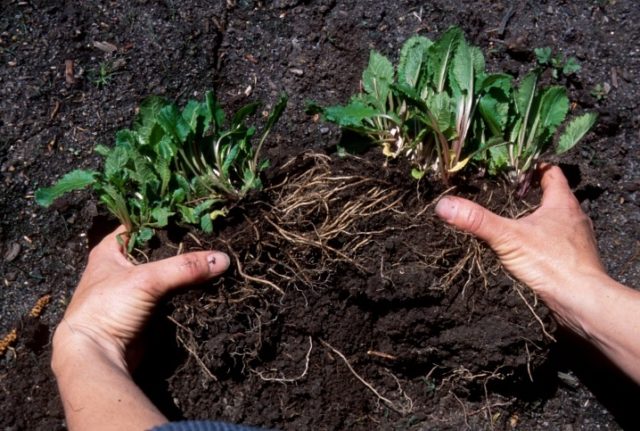
The roots of the plant are strong enough, elastic
Ideally, the root of a healthy plant has a light, uniform color. Before planting, you can immerse it in a stimulant solution, such as root, for a couple of hours. This will help the plant adapt.
Landing rules
A hole is dug approximately 45 cm deep and a drainage layer is placed on the bottom. A layer of earth is laid on top of the drainage, chrysanthemum bushes are moistened and planted. Dig in, and without fail mulch the root zone.
Needles, shavings or sawdust are most often used as mulch. Despite the simplicity of care, the plant needs care. It consists in timely watering and feeding, as well as preparation for the winter season.
Plants are planted in open ground at a distance of half a meter from each other. For planting in pots, you should choose a fairly spacious container.
Chrysanthemum Santini Care
Chrysanthemum does not require special attention to itself, but is responsive to quality care. It needs a place well lit by the sun's rays. The plant does not tolerate a lack of light and excess moisture.
Too high humidity is also unacceptable. Chrysanthemum Santini needs regular loosening, watering and feeding.
Optimal growing conditions
Chrysanthemums are short-day plants. For early varieties, it is 13 - 14 hours, for mid-late - 11 - 13 hours, for late - 14 - 15. Santini growing indoors requires additional lighting in winter. This applies to varieties that bloom all year round.
For those plants that are dormant after flowering, light is not needed. Chrysanthemums planted from the site in pots are placed in a dark room with a temperature of +2 to 5 degrees. It is important that the indicators in this room do not drop to zero.
For chrysanthemums, with proper watering, air humidification is carried out as needed. You just need to make sure that drops of sprayed water do not fall on the inflorescences, and do not accumulate in them. Chrysanthemum leaves should not be wetted too abundantly.
The optimal temperature range for chrysanthemums is considered to be a temperature range of 10 to 17 degrees. The maximum air temperature is +22 degrees. At higher rates, inhibition of the bud buds occurs.
Watering mode for chrysanthemum Santini
The plant needs regular watering. It needs to be done 1 - 2 times a week, depending on weather conditions. During the dormant period, it is not necessary to feed and water the plant.
Before watering, you need to loosen the soil. Watering is carried out at the root of the plant, after which the root areas are mulched. Excess moisture must not be allowed.
During the budding period, the plant needs frequent moderate watering. With the onset of flowering, it is reduced. Before sheltering for the winter, they stop.
Top dressing
Top dressing can be started 2 weeks after planting. The composition of nutritional mixtures depends on the periods of development:
- during the formation of buds, potassium-phosphorus fertilizers are applied;
- leaf formation - top dressing with potash fertilizers;
- the formation of the first buds and leaves on the cuttings - the introduction of ammonium nitrate.
You can not make top dressing during the period of coloring of the buds.
Trimming and shaping
Since chrysanthemum Santini is a compact plant, it does not need to form a bush. The flower itself creates a wonderful shape.
But it is necessary to remove dried and diseased leaves and inflorescences in a timely manner. Before sheltering for the winter, the stems of the bushes are cut off, leaving hemp.
In rare cases, it becomes necessary to form a bush. This usually happens when the growing conditions are not appropriate for the species. To form a bush, you can apply the method of pinching the apical shoots.
Shelter for the winter
Despite the frost resistance, in the middle lane, the Santini chrysanthemum should either be covered for the winter, or transplanted into pots and brought into the room for the winter.
Dry twigs, spruce branches, agrofibre or film are used as a covering material. For regions with mild winters, it is enough to cover the plant with spruce branches.
Diseases and pests
Chrysanthemum Santini has good immunity, is rarely affected by diseases. The plant is resistant to pest attacks. But sometimes these moments do happen. The table shows how to deal with problems caused by pathogenic flora or insects.
Problem | Decision |
Fungus damage (powdery mildew). It occurs due to the high acidity of the soil, excess nitrogen. | Application of fungicides, cancellation of planned fertilizing with nitrogenous fertilizers. |
Rotting roots as a result of stagnant water. | Reducing the amount of water when watering. Drainage during planting can prevent the problem. |
The defeat of aphids, miner flies, slugs. | At the first sign, the top layer of the soil is removed, replacing it with a new one. They are treated with fungicides. |
Reproduction of chrysanthemum Santini
Since the Santini chrysanthemum belongs to the species of hybrid plants, it can be propagated by dividing an old bush or by cuttings.
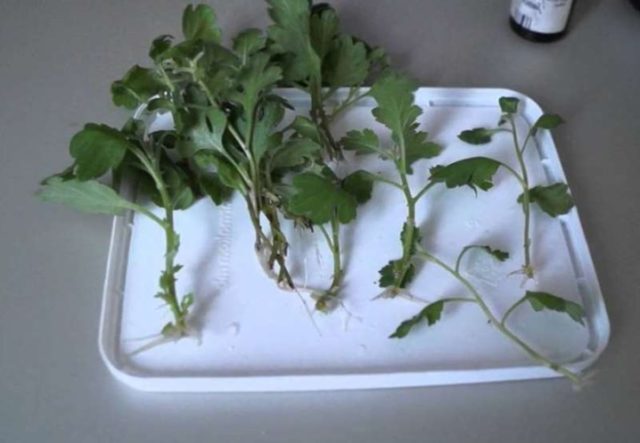
Seedlings obtained by cuttings take root quite well
The division of the bush can be done at any time. Blooming is not a reason to avoid manipulation. Adult bushes are suitable for dividing. The separated part with the root is immediately transplanted to a permanent place.
For propagation by cuttings, the apical branches are cut off with a length of 10 - 15 cm and placed obliquely in the soil mixture. Do it in the spring or summer.
For rooting cuttings, certain rules must be followed:
- Temperature range - +20 - 22 degrees.
- The humidity indicator is 80%.
- Regular watering.
In such conditions, the cuttings are 7 days. After the roots appear, young plants are immediately planted in the ground, guided by the rules of planting and site selection.
Conclusion
Chrysanthemum Santini blooms for 40 - 60 days. This means that the personal plot will be pleasing to the eye until late autumn. The plant is popular with gardeners, florists, landscape designers and indoor florists. Cut flower arrangements also look fresh and beautiful for a long time.






